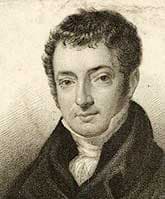Washington Irving
Critique • Works
 WASHINGTON IRVING, portrait c. 1810 by John Roffe
WASHINGTON IRVING, portrait c. 1810 by John RoffeBorn
New York City, United States, 1783
Died
Tarrytown, New York, 1859
Places lived
New York City, United States; England; Paris, France; Dresden, Germany; Madrid, Spain; Tarrytown, United States
Nationality
American
Publications
Stories, essays, biography, history, travel, letters
Genres
Literary, fantasy, satire, romantic history
Writing language
English
Literature
• "The Legend of Sleepy Hollow" (1820)
Stories
• "Rip Van Winkle" (1819)
• "The Legend of Sleepy Hollow" (1820)
Story Collections
• The Sketch Book of Geoffrey Crayon, Gent. (1819–1820)
American Literature
• "Rip Van Winkle" (1819)
• "The Legend of Sleepy Hollow" (1820)
Fantasy Stories
• "The Legend of Sleepy Hollow" (1820)
America's first literary star
Washington Irving is not a name that comes up in discussions of great authors, but at least two of his stories have become American classics of a sort.
The sort of classics we mean are tales that have been told and retold in various forms—in films, in simplified kids' books, in cartoons, in loose parodies—and are referred to in everyday language, without those who retell and rehear the tales ever reading the original sources.
Everyone has heard of the character Rip Van Winkle of course and everyone has enjoyed other stories of heroes who awake in a future time, but few know firsthand Washington Irving's story "Rip Van Winkle" which gave birth to all those others. And while many can recall varied tales of some headless horseman or another, most have never read Irving's "The Legend of Sleepy Hollow" that popularized the notion.
And still fewer have worked through Irving's great collection, The Sketch-Book of Geoffrey Crayon, Gent., first published serially in 1819 and 1820 and including his two most famous tales.
Before this, Irving had already co-written and published a collection of satirical essays Salmagundi, or The Whim-Whams and Opinions of Launcelot Langstaff & Others (1807–1808, also known as The Salmagundi Papers), and had singly produced the comic work A History of New York from the Beginning of the World to the End of the Dutch Dynasty (1809) under the pseudonym Dietrich Knickerbocker. The latter made "Knickerbocker" a popular slang term for Dutch settlers in Manhattan.
A very odd book
But it was The Sketch-Book that is considered a milestone as the first American work of fiction to win international—by which was then meant European—acclaim.
It's a very odd book at that. It purports to contain the writings of one Geoffrey Crayon, an American travelling in Britain and commenting on British life: country churches, English writers, old-country Christmas celebrations, and eccentric individuals he meets. Among these witty essays are fictional stories from other countries. Sometimes an attempt is made to introduce them as tales told Mr. Crayon by English subjects in his travels, but often they're just dropped in without excuse.
In addition to the famous U.S.-based tales, "Rip Van Winkle" and "The Legend of Sleepy Hollow", is a fantastic story from Germany of equal thrills, "The Spectre Bridegroom". Reading these you can anticipate Irving's influence on Edgar Allan Poe.
After the success of The Sketch-Book, Irving continued to straddle old and new world culture. He lived abroad for 17 years, which included three years as a diplomatic attaché in Spain, producing the biography The Life and Voyages of Christopher Columbus (1828), the humorously told history The Conquest of Granada (1829), and a collection of sketches and stories from Spain, Legends of the Alhambra (1832, substantially revised in 1851).
Returning to the United States in 1832, he published Legends of the Conquest of Spain (1835) but focused mainly on Western American settings in his books A Tour of the Prairies (1835), Astoria (1836) and The Adventures of Captain Bonneville (1837). His biographical works, showing his continuing broad range of interests, include Mohammed (1849) and George Washington (1855-59 in five volumes).
Most of these works are forgotten today except to literary historians, but many of Irving's observations and bon mots are still bandied about today. For example, the reference to a big city as "Gotham" and the phrase "the almighty dollar" first appeared in his works.
Mainly though, it's the old sleeper Rip Van Winkle and the scene of Ichabod Crane fleeing the ghastly horseman that Washington Irving is remembered for.
— Eric
Critique • Works

